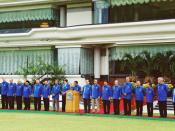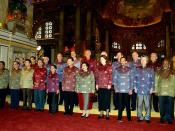"The economic development of Asian 'Miracle' economies"
After the Second World War most of the Asian economies were agricultural economies. Thereafter the economies shifted from the traditional products to light industries such as electronics and textiles. Some Asian countries also stressed larger-scale industrial projects. The first years of economic development were in the golden of the dirigiste doctrine. This period can be characterized by state-led development and inward oriented industrialization.
In mid 1960s there was critique of the import-substituting industrialisation and the ASEAN economies turned more and more into free market countries, especially Hong Kong. The so called Asian dragons like Japan, Korea and Taiwan were developing with great pace. Especially the Japanese economy was developing into an economic powerhouse with high speed, partly due to the American support they received after the Second World War. The new ASEAN economies have benefited from the development of these Asian Dragons, because of the transfer of technologies.
This transfer of technologies can be by characterized by the "flying geese" pattern of industrial development. "Japan succeeded in catching up with the West while pulling up a number of the region's developing economies along the way." (Chung H. Lee, 1998) In table one you can see how the different countries moved forward to the different product cycles. The availability of these technologies combined with cheap labour in the Asian countries and the enhancing political environment attracted investments of multinationals.
In the mid-1980s the ASEAN economies expanded their economic relations with china to expand and diversify their exports. Especially Japan had an important role in the success of China's economic reforms and open-door policy. The ASEAN economies started also other regional structures. Examples of these regional structures are the subregional SREZs, the regional ASEAN free trade area and the Supra-regional Asia Pacific Economic Cooperation (APEC)...



Asian economies
Yours is a good essay on the development of the Asian miracle economies but you need a bibliography to supplement any internal citation. You should also either include Table 1 or omit any reference to it.
6 out of 6 people found this comment useful.